Can Fleas Travel on Humans to Another House?
Fleas are known for their ability to quickly infest homes and cause havoc for both humans and pets. One common question that arises is whether fleas can travel on humans and spread to another house. While humans can unwittingly transport fleas, they are not the preferred hosts for these pesky parasites.
Unlike animals with fur or feathers, humans lack the ideal environment for fleas to thrive. However, fleas can temporarily grab onto human skin or hair if they come into contact, but they are unlikely to stay there for long. Instead, fleas often find clothing, socks, or other fabric more appealing and hitch a ride back to the human’s home. If not dislodged before reaching home, the fleas can potentially infest the new house.
Another factor to consider is that fleas can embed themselves in rugs, sofas, and other objects in a home, which can then be transported to another location along with the fleas. This means that even if a human host does not carry fleas directly on their body, they can still unintentionally introduce these pests to a new house through infested items.
To prevent human-mediated flea infestations, it is crucial to take certain precautions. When visiting flea-infested areas, such as a friend’s or neighbor’s home, avoid direct contact with infested objects and limit interaction with pets in those environments. After leaving a potentially infested place, thoroughly inspect yourself and your clothing for any signs of fleas and promptly remove them. Additionally, regularly launder and vacuum your own home to minimize the risk of fleas gaining a foothold.
While fleas may not be common on humans, it is essential to address any flea infestation in the home promptly. Fleas can quickly multiply and cause discomfort and health risks for both humans and pets. By understanding the potential for human-mediated flea transmission and taking preventive measures, you can protect your home and keep it flea-free.
Key Takeaways:
- Fleas can potentially be carried by humans from one home to another, although they are more likely to be found in places other than on the human host’s skin.
- While humans may not be preferred hosts for fleas, they can still serve as a means of transportation for the parasites.
- Preventing human-mediated flea infestations involves taking precautions when visiting flea-infested areas and thoroughly inspecting yourself and your clothing afterwards.
- Regularly laundering and vacuuming your home can also help minimize the risk of fleas gaining a foothold.
- Address any flea infestation in your home promptly to prevent further spread and protect the health and well-being of residents.
How Do Fleas Get on Humans?
Fleas typically do not live on humans but can still bite them. The most common way for fleas to get on humans is through contact with infested pets. Fleas can jump up to 13 inches, so it is possible for them to hitch a ride on a person if they come into contact with an infested dog or cat. Additionally, fleas can be transferred to humans through infested rugs, clothing, or furniture. Although humans are not ideal hosts for fleas, they can still be bitten by the parasites.
List of Common Ways Fleas Get on Humans:
- Contact with infested pets
- Coming into contact with infested rugs, clothing, or furniture
In addition to hitchhiking on humans, fleas may also attach themselves temporarily to human skin or hair before finding a more suitable host or hiding place. While fleas do not typically live on humans for extended periods, they can still cause discomfort through their bites.
The most common way for fleas to get on humans is through contact with infested pets. Fleas can jump up to 13 inches, so it is possible for them to hitch a ride on a person if they come into contact with an infested dog or cat.
To visually illustrate how fleas get on humans, refer to the table below:
| How Fleas Get on Humans | Likelihood |
|---|---|
| Contact with infested pets | High |
| Coming into contact with infested rugs, clothing, or furniture | Moderate |
| Direct attachment to human skin or hair | Low |
Can Humans Carry Fleas from One Home to Another?
Humans can unintentionally carry fleas from one home to another. When a person comes into contact with fleas in an infested location, such as a friend’s or neighbor’s home, the fleas can attach themselves to the person’s skin, hair, or clothing. This human-mediated flea transmission can then result in the transportation of fleas to the person’s own home.
While humans may not be the preferred hosts for fleas due to the lack of suitable conditions, they can still act as carriers. Fleas can hitch a ride on humans and use them as a means of transportation. It is crucial to exercise caution when visiting flea-infested areas to prevent the inadvertent introduction of fleas into one’s own home.
Remember: Taking preventive measures and practicing good hygiene can help avoid unintentionally carrying fleas. Regularly inspect your clothing, hair, and skin for any signs of fleas after visiting infested areas.
Precautions to Prevent Flea Transmission:
- Wear protective clothing, such as long sleeves and pants, when visiting flea-infested environments.
- Use insect repellent to deter fleas from latching onto your skin.
- After being in a potentially infested area, shake out your clothing and brush off any visible fleas.
- Immediately wash any clothing that may have come into contact with fleas.
- Regularly vacuum and clean your living spaces to minimize the risk of flea infestation.
By being mindful of these precautions, you can help prevent the unintentional transmission of fleas from one location to another and maintain a flea-free home.
Do Fleas Live on Humans?
Fleas do not typically live on humans. They prefer to inhabit the fur or feathers of animals, where they can find warmth and sustenance. While fleas may temporarily grab onto human skin or hair, they are unlikely to stay there for extended periods. Humans lack the necessary factors, such as fur or feathers, for fleas to thrive. Instead, fleas may seek refuge in clothing, socks, or other fabric, where they can travel with humans to different locations.
Although fleas do not live on humans, it’s important to note that they can still bite humans and cause discomfort. Flea bites can result in itching, redness, and in some cases, an allergic reaction. Therefore, it’s crucial to take necessary precautions to prevent flea infestations in your home and protect yourself and your family from flea bites.
Common Misconceptions about Fleas Living on Humans
“I’ve heard that fleas can live on humans and lay eggs in their hair. Is that true?”
This is a common misconception about fleas. While fleas may occasionally find their way into human hair, they do not typically infest it. Fleas are adapted to live on animals with fur or feathers, which provide the necessary warmth and hiding places for the parasites. Human hair does not offer the same favorable conditions for fleas to establish a permanent presence. However, fleas can momentarily grab onto human hair before they are dislodged or jump off to find a more suitable host or hiding place.

| Fleas living on humans | Fleas living on animals |
|---|---|
| Fleas may grab onto human skin or hair temporarily. | Fleas prefer to inhabit the fur or feathers of animals. |
| Fleas are unlikely to stay on humans for extended periods. | Fleas can establish a permanent presence on animals. |
| Humans lack the necessary factors, such as fur or feathers, for fleas to thrive. | Animals provide warmth and hiding places for fleas. |
How Long Can Fleas Survive on Humans?
Fleas cannot survive on humans for extended periods. Without a blood meal, fleas can typically survive for only a few days to a couple of weeks. Humans do not provide the ideal environment for fleas to reproduce and thrive. The lack of fur and other factors necessary for their survival limits their ability to stay on humans for long periods. Fleas rely on furry or feathery hosts to lay eggs and continue their life cycle.
In comparison, fleas can survive for up to two months on animal hosts, such as dogs or cats, which provide the necessary conditions for their reproduction and overall survival. On these hosts, fleas can lay eggs, which then develop into larvae and pupae, completing their life cycle.
Although fleas may bite humans and cause discomfort, they do not establish long-term infestations on human hosts. Fleas are highly specialized parasites that have evolved to thrive on specific hosts with the necessary attributes for their survival. Humans simply do not meet those requirements.
| Host | Flea Lifespan |
|---|---|
| Dogs | Up to 2 months |
| Cats | Up to 2 months |
| Humans | Up to a few days to a couple of weeks |
Can Fleas Live in Human Hair?
While fleas may occasionally find their way into human hair, they do not typically infest it. Fleas are adapted to live on animals with fur or feathers, which provide the necessary warmth and hiding places for the parasites. Human hair does not offer the same favorable conditions for fleas to establish a permanent presence. However, fleas can momentarily grab onto human hair before they are dislodged or jump off to find a more suitable host or hiding place.
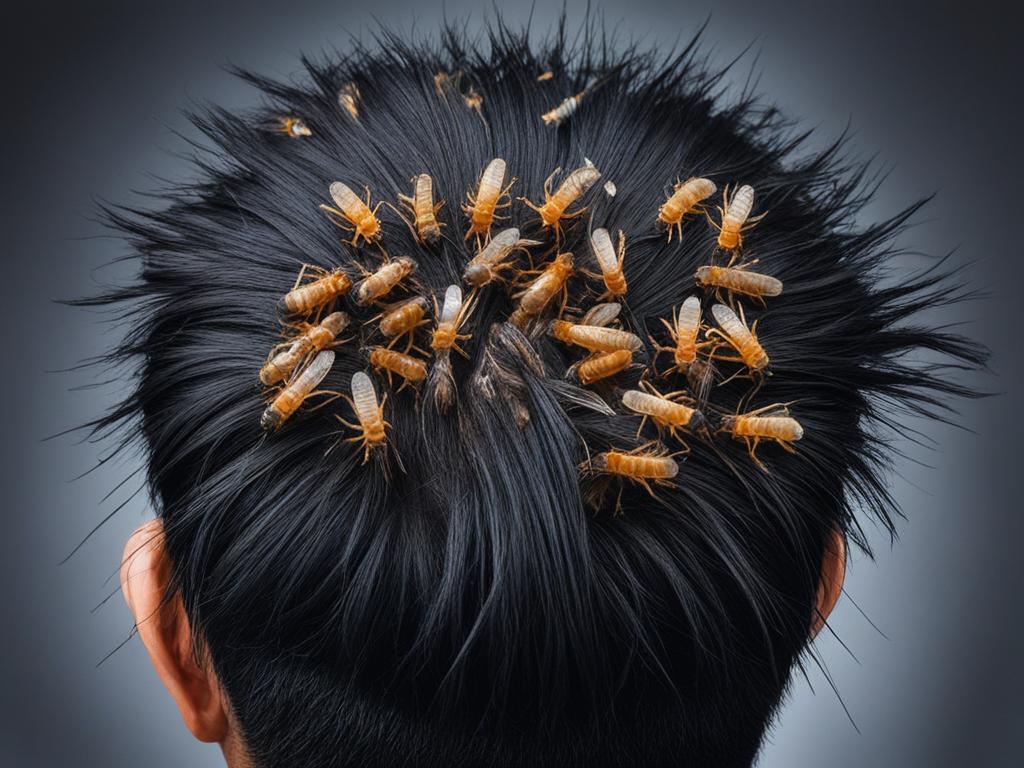
How to Prevent Human-Mediated Flea Transmission
Fleas can be inadvertently carried from one location to another by humans, which can lead to the introduction of flea infestations in new environments. To avoid unintentionally transmitting fleas, it is essential to take certain precautions:
- Avoid Direct Contact: When visiting flea-infested areas, such as a friend’s or neighbor’s home, try to avoid direct contact with infested objects like rugs, furniture, or clothing. Fleas can easily latch onto these items and hitch a ride to your home.
- Limit Contact with Pets: If possible, limit your interactions with pets in flea-infested environments. Pets are common carriers of fleas, and minimizing contact can reduce the risk of fleas transferring onto you and accompanying you back to your home.
- Thorough Inspection: After visiting a potentially infested place, it is crucial to thoroughly inspect yourself and your clothing for any signs of fleas or infestation. Look out for the presence of fleas, flea dirt (dark specks that indicate flea waste), or any itching or bites on your skin.
- Safe Removal: If you detect any fleas on your body or clothing, promptly remove them. You can use a flea comb or sticky tape to capture and dispose of any live fleas. Be cautious not to squash the fleas, as this can release eggs and exacerbate the infestation.
- Wash and Vacuum: To minimize the risk of fleas gaining a foothold in your home, it is essential to regularly launder and vacuum your personal belongings. Wash your clothes at a high temperature to eliminate any potential hitchhikers, and frequently vacuum your home, paying attention to carpets, rugs, and upholstery where fleas may hide.
By following these preventive measures, you can significantly reduce the chances of unintentionally transmitting fleas and prevent human-mediated flea infestations in your home.
Thorough Inspection for Fleas
“Regular inspections after visiting flea-infested areas are crucial to detect and remove fleas promptly.”
Understanding Flea Infestations and Their Impact on Homes
Flea infestations can have significant consequences for homes and their inhabitants. Once fleas enter a house, they can quickly multiply and infest the interior. Fleas primarily feed on pets, but they can also bite humans and cause discomfort and itching. In severe infestations, fleas can pose health risks to animals and humans.
Flea bites can lead to allergic reactions and skin irritations. Some flea species can even transmit diseases like plague and typhus, posing a serious threat to the well-being of both pets and people. Prompt action is essential to address a flea infestation in a timely manner in order to prevent further spread and protect the health and well-being of the residents.
“Flea infestations can quickly overrun a home, leading to numerous bites and potential health risks. It is crucial to take immediate steps to eradicate fleas and prevent their return.”
The Consequences of Flea Infestations
Flea infestations can have several negative effects on homes and their occupants:
- Discomfort and irritation from flea bites
- Allergic reactions and skin irritations
- Secondary infections from scratching the bites
- Potential transmission of diseases like plague and typhus
- Costly extermination and treatment measures
These consequences highlight the importance of proactive flea prevention and effective treatment to maintain a safe and comfortable living environment.

Preventing Flea Infestations and Protecting Your Home
Preventing flea infestations in homes is key to maintaining a healthy living environment. Here are some preventive measures to consider:
- Regularly treat pets with veterinarian-recommended flea control products.
- Keep the home clean by vacuuming regularly and washing pet bedding frequently.
- Minimize potential entry points by sealing cracks and gaps in walls and floors.
- Avoid contact with stray animals that may carry fleas.
- Consult with a professional pest control service for regular inspections and treatments.
By taking these preventive measures, you can significantly reduce the risk of flea infestations in your home and ensure the well-being of both your family and pets.
Treating Flea Infestations in Homes
Treating a flea infestation in your home requires a comprehensive approach to effectively eliminate these pesky pests. By following the right steps, you can rid your house of fleas and create a flea-free environment for you and your pets.
Treat Your Pets
Start by treating your pets with appropriate flea control products recommended by a veterinarian. Fleas often infest pets and use them as a host for blood meals. Treating your pets will not only provide them relief from flea bites but also help break the flea life cycle by killing adult fleas and preventing their reproduction.
Thoroughly Clean and Vacuum
Thoroughly clean and vacuum the entire house to remove fleas and their eggs from your environment. Pay special attention to areas where your pets spend time, such as bedding, furniture, and carpets. Fleas and their eggs can easily hide in these areas. Dispose of vacuum bags immediately or clean vacuum canisters to prevent fleas from reinfesting your home.
Target Flea Hiding Spots
Consider using insecticides or natural remedies specifically formulated for flea control to target areas where fleas are likely to hide. Cracks, crevices, and your pet’s resting areas are common hiding spots for fleas. These products can help eliminate fleas at various stages of their life cycle, disrupting their reproduction and population growth.
Repeat Treatment if Necessary
It may be necessary to repeat the treatment multiple times to fully eliminate the flea infestation. Fleas can be resilient, and their eggs can hatch over time, leading to new infestations. By repeating the treatment as recommended, you can ensure that all fleas and eggs are thoroughly eradicated.
Remember, treating a flea infestation in your home requires persistence and consistency. Monitor your pets for any signs of fleas and continue practicing preventive measures to minimize the risk of future infestations.
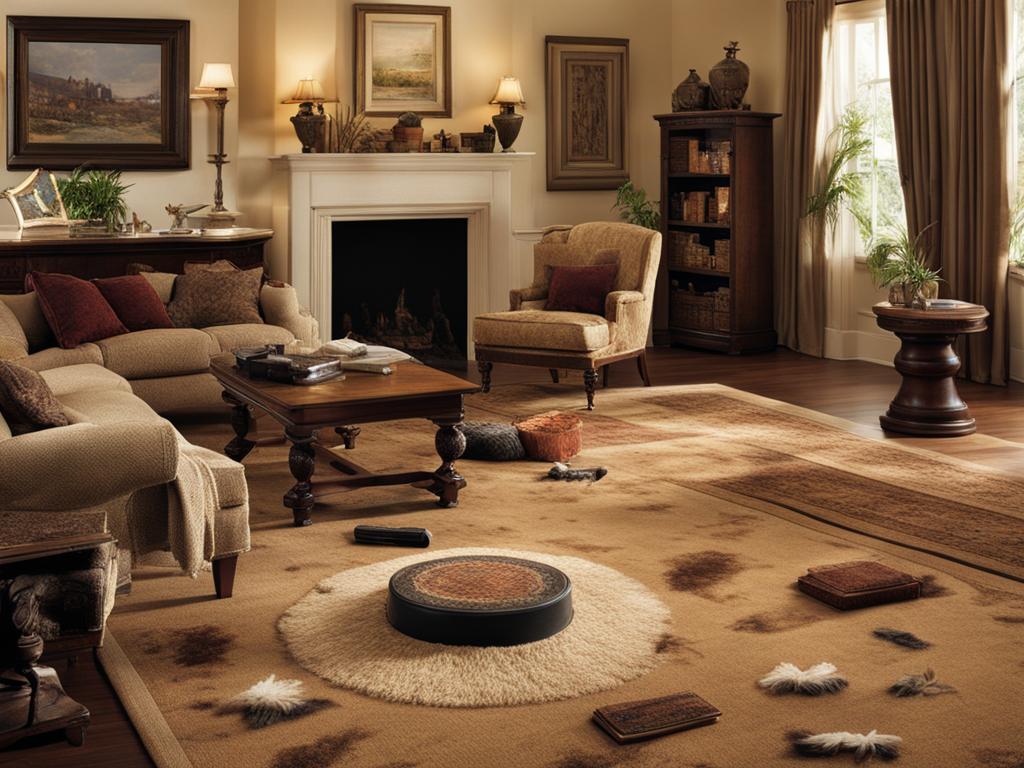
Preventing Flea Infestations in Homes
Preventing flea infestations in houses is crucial to maintaining a healthy and comfortable living environment. By implementing a few simple measures, you can significantly reduce the risk of fleas taking hold in your home. Here are some flea prevention measures for homes:
Regularly Inspect and Treat Your Pets
To prevent fleas from entering your home, it’s essential to keep your pets flea-free. Regularly inspect your pets for any signs of fleas, such as excessive scratching or small black dots on their skin, known as flea dirt. If you detect fleas, consult with a veterinarian to ensure the most appropriate and effective flea control products are used to treat your pets.
Keep Your Home Clean and Tidy
A clean and tidy home is less attractive to fleas. Vacuum your home regularly, paying special attention to areas where your pets spend time, such as carpets, rugs, and furniture. Dispose of the vacuum bag immediately to prevent fleas from reinfesting your home. Additionally, wash your pet’s bedding frequently in hot water to eliminate any existing fleas or eggs.
Use Preventive Flea Control Products
Consider using preventive flea control products, such as spot-on treatments or flea collars, for your pets. These products can help repel and kill fleas, reducing the chances of an infestation. Always follow the product instructions and consult with a veterinarian to ensure the appropriate use and effectiveness of these preventive measures.
Create Barriers to Prevent Stray Animals
Stray animals, such as neighborhood cats or dogs, can introduce fleas into your home. To prevent them from entering your property, consider installing fences or using natural deterrents, such as motion-activated sprinklers or noise-emitting devices. By creating barriers, you reduce the risk of stray animals bringing fleas onto your premises.
Treat Outdoor Areas
If you have outdoor animals or spend time in outdoor spaces where fleas may be present, regularly treat these areas with flea control products. Focus on areas where your pets rest, such as kennels or favorite lounging spots. This preventive measure helps minimize the chances of fleas hitching a ride into your home.
By following these preventive measures, you can significantly reduce the risk of flea infestations in your home, ensuring a safe and comfortable environment for both you and your pets.
Potential Health Risks Associated with Fleas
Fleas can pose significant health risks to both animals and humans. These tiny parasites are not just annoying; they can also transmit diseases, making it essential to address flea infestations promptly and take appropriate preventive measures.
One of the most concerning diseases transmitted by fleas is plague. While relatively rare, plague remains a serious threat in certain regions, particularly in areas where rodents carrying infected fleas are present. Fleas can also transmit typhus in certain circumstances, which is another potentially severe illness.
“Fleas serve as vectors for diseases like plague and typhus, making them more than just a nuisance.”
In addition to the risk of disease transmission, flea bites can cause a range of health issues. Some individuals may experience allergic reactions to flea saliva, leading to intense itching, swelling, and discomfort. Scratching and excessive itching can create breaks in the skin, making it easier for bacteria to enter and cause secondary infections.
Flea allergy dermatitis is another condition that can develop in pets due to flea bites. This condition causes severe itching and skin inflammation, leading to hair loss and skin infections. In severe infestations, pets may also experience anemia due to the blood loss caused by numerous flea bites and ongoing feeding.
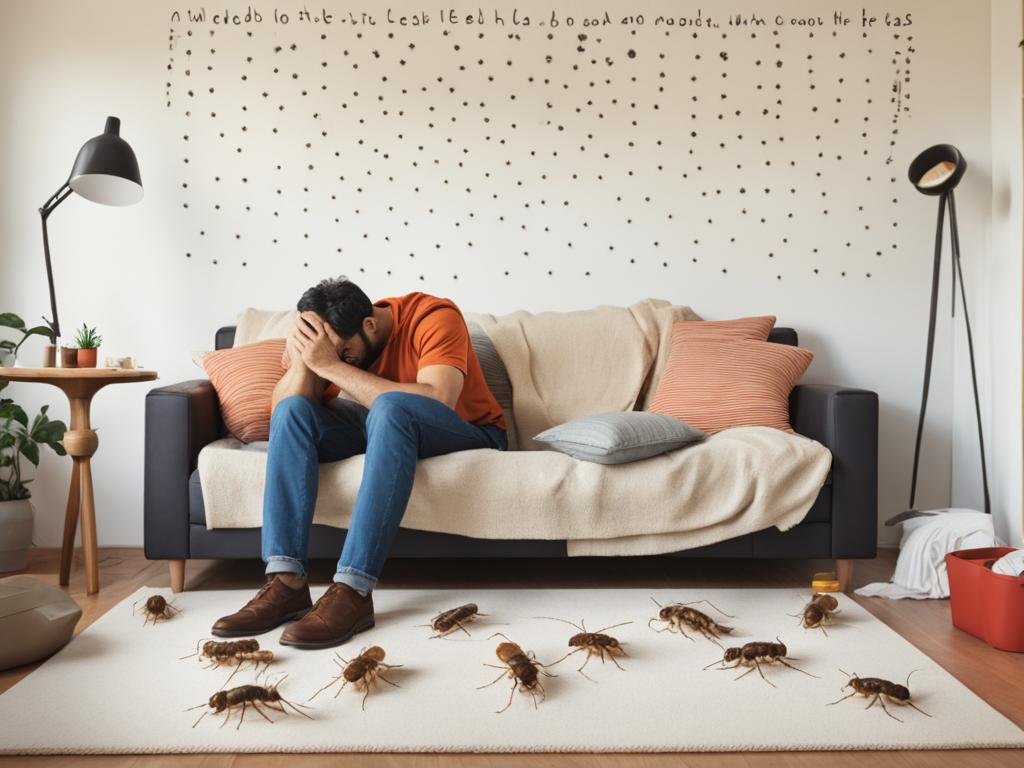
Flea-Related Health Risks:
- Transmit diseases such as plague and typhus in certain regions
- Can cause allergic reactions, intense itching, and discomfort
- May lead to secondary skin infections
- Contribute to flea allergy dermatitis in pets
- Can result in anemia in pets due to ongoing feeding
To protect the health and well-being of both pets and humans, it is crucial to take flea infestations seriously. Seek appropriate medical care if you have concerns about flea-related health issues and ensure prompt treatment of flea infestations to prevent the spread of diseases and alleviate discomfort.
Common Mistakes in Dealing with Flea Infestations
When it comes to dealing with flea infestations, there are common mistakes that can impede effective control. It is important to avoid these pitfalls to ensure successful flea eradication. Let’s explore some of the most common mistakes and how to avoid them.
1. Focusing Solely on Treating Pets
One common mistake is solely focusing on treating pets without addressing the entire home environment. While treating pets is crucial, it’s equally important to tackle the fleas hiding in various areas of your home. Fleas can hide in bedding, furniture, carpets, and other fabric surfaces. To effectively control fleas, a comprehensive approach that includes treating both pets and the home is necessary.
2. Using Improper Flea Control Products
Using improper flea control products or applying them incorrectly can significantly reduce their efficacy. It’s vital to choose flea control products that are specifically formulated for the type of infestation you’re dealing with. For example, using a product meant for cat fleas on dogs can be ineffective and vice versa. Always follow the instructions provided by the manufacturer and consult with a veterinarian if you have any doubts or concerns.
3. Neglecting Repeat Treatments and Preventive Measures
Neglecting to follow through with repeat treatments and preventive measures can lead to recurring flea infestations. Fleas have a life cycle that includes eggs, larvae, pupae, and adult stages. Treating only adult fleas may not fully eradicate the infestation, as eggs and larvae can still be present in the environment. Regularly repeating treatments, as recommended by the product manufacturer or a professional, helps ensure the elimination of all life stages. It’s also essential to implement preventive measures, such as vacuuming regularly and using flea prevention products, to minimize the risk of future infestations.
4. Ignoring Professional Assistance
In severe or persistent flea infestations, ignoring professional assistance can be a mistake. Pest control professionals have the expertise and tools to effectively eliminate fleas from your home. They can assess the extent of the infestation, determine the best treatment approach, and apply appropriate insecticides to target fleas at all stages of their life cycle. Don’t hesitate to seek professional help if your flea problem persists or escalates.
In summary, when dealing with flea infestations, it is important to avoid common mistakes that can hinder effective control. By taking a comprehensive approach, using appropriate flea control products, following through with repeat treatments and preventive measures, and seeking professional assistance when needed, you can successfully eradicate fleas from your home and prevent future infestations.
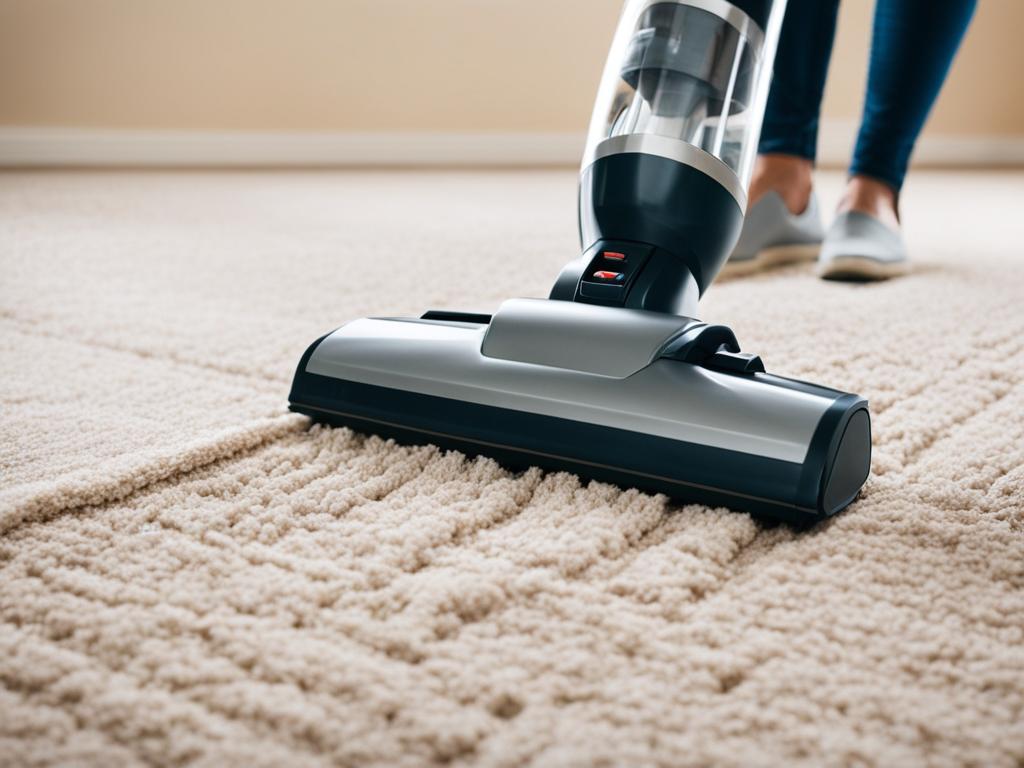
| Mistake | Consequence |
|---|---|
| Focusing solely on treating pets | Leaves fleas in the home environment, leading to reinfestation |
| Using improper flea control products | Reduces efficacy of treatment, allowing fleas to persist |
| Neglecting repeat treatments and preventive measures | Allows fleas in different life stages to survive and multiply |
| Ignoring professional assistance | Can lead to ineffective control and prolonged infestations |
DIY Methods for Flea Control
If you’re dealing with a flea infestation in your home, there are several DIY methods you can try to control the problem. While these natural remedies may not be as comprehensive or effective as professional pest control treatments, they can be a good starting point for managing fleas in your home.
1. Diatomaceous Earth
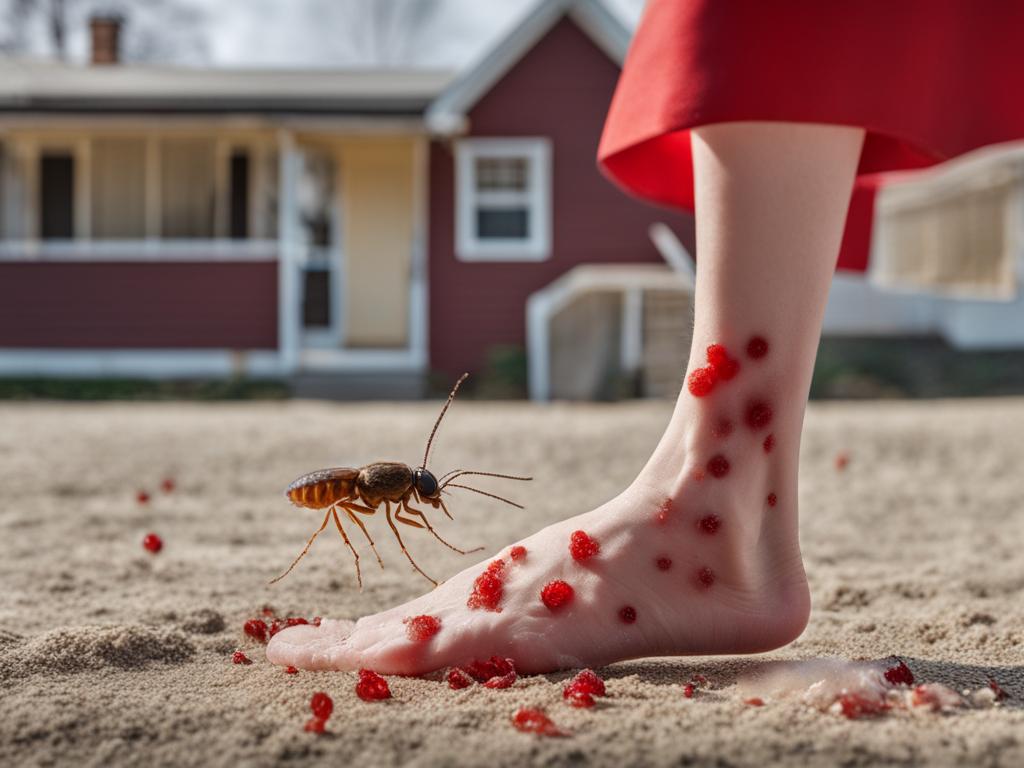
Diatomaceous earth is a natural substance that can help dehydrate and kill fleas. It is made from the fossilized remains of tiny aquatic organisms called diatoms. Sprinkle diatomaceous earth in areas where fleas are present, such as carpets, pet bedding, and cracks in the floor. Leave it for a few days, then vacuum thoroughly to remove dead fleas and the diatomaceous earth.
2. Baking Soda
Baking soda is another DIY remedy that can help eliminate fleas from your home. Sprinkle baking soda on carpets, furniture, and pet bedding. Leave it for a few hours or overnight, then vacuum thoroughly to remove the baking soda and any dead fleas. Baking soda can help dehydrate and kill fleas by altering their pH balance.
3. Salt
Salt is a simple and affordable DIY method for flea control. Sprinkle table salt or sea salt on carpets, pet bedding, and other infested areas. Leave it for a few days, then vacuum thoroughly to remove the salt and any dead fleas. The salt acts as a desiccant, absorbing moisture from the fleas and causing them to die.
4. Washing Pet Bedding
Regularly washing your pet’s bedding with hot water and soap can help eliminate fleas and their eggs. Fleas prefer to lay their eggs in warm, cozy places, so washing the bedding at high temperatures can kill both the adult fleas and their eggs.
5. Vacuuming
Vacuuming frequently is an important step in flea control. Use a vacuum cleaner with strong suction power to thoroughly clean carpets, upholstered furniture, and other areas where fleas may be hiding. After vacuuming, dispose of the vacuum bag immediately to prevent fleas from escaping and reinfesting your home.
While these DIY methods can help control fleas to some extent, it is important to note that they may not be sufficient for severe or persistent infestations. If DIY methods fail to control the flea problem, it is advisable to seek professional pest control assistance to ensure effective elimination of fleas and prevention of future infestations.
Professional Pest Control for Flea Infestations
In severe or persistent flea infestations, it may be necessary to seek professional pest control services. Pest control professionals have the expertise and tools to effectively eliminate fleas from your home.
They can assess the extent of the infestation, determine the best treatment approach, and apply appropriate insecticides to target fleas at all stages of their life cycle. Professional pest control services can provide long-lasting solutions and help prevent future infestations by implementing preventive measures.
When hiring a pest control company for flea control, it’s important to look for one with experience in dealing with fleas and a good reputation for effective and safe treatments. Qualified professionals can ensure that the infestation is addressed thoroughly, minimizing the risk of reinfestation.
“Professional pest control services have the expertise and tools to effectively eliminate fleas from your home.”
By enlisting the help of professionals, you can have peace of mind knowing that the flea infestation will be effectively treated, protecting the health and well-being of your family and pets.
| Benefits of Professional Pest Control for Flea Infestations |
|---|
| Thorough assessment of infestation |
| Targeted treatment for fleas at all life stages |
| Effective application of insecticides |
| Implementation of preventive measures |
| Expertise in flea control |
| Safe and reliable treatments |
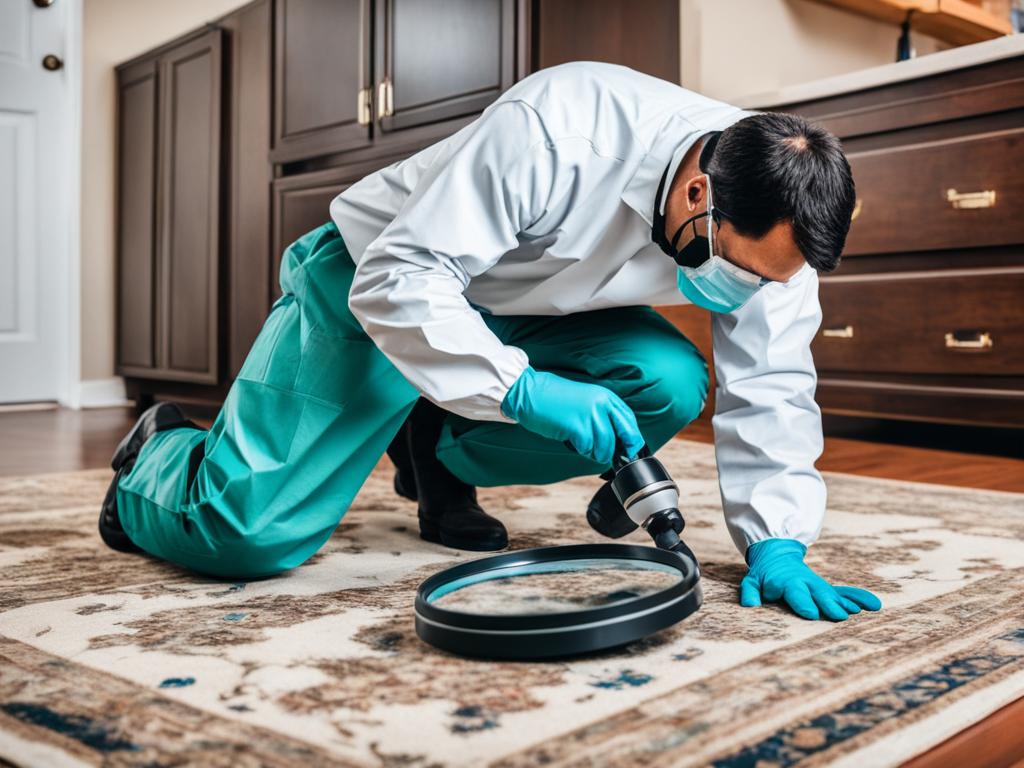
With professional pest control, you can ensure that flea infestations are dealt with effectively, minimizing the risk of recurring infestations and protecting your home from the harmful effects of fleas.
Remember to consult with a reputable pest control company to address your flea infestation and implement long-term preventive measures to keep your home free from fleas.
Ensuring Long-Term Prevention of Flea Infestations
Maintaining a flea-free home requires ongoing preventive measures. By following these steps, you can minimize the risk of future flea infestations and keep your home free from these pesky parasites.
Treating your Pets
Regularly treat your pets for fleas using preventive products recommended by a veterinarian. These products can include topical spot-on treatments, flea collars, or oral medications. It is important to follow the instructions provided by your veterinarian and administer the treatment consistently to ensure maximum effectiveness.
Cleaning and Maintaining Your Home
To keep your home flea-free, it is essential to maintain proper cleanliness. Vacuum your home regularly, paying particular attention to areas where your pets spend the most time, such as carpets, rugs, and upholstery. Additionally, wash your pet’s bedding frequently using hot water and a detergent that is safe for pets. By removing potential flea habitats, you reduce their chances of reproducing and infesting your home.
Implementing Preventive Barriers
Create preventive barriers to keep fleas away from your property. Use flea collars or apply spot-on treatments to your pets to repel fleas. These products act as a barrier, preventing fleas from infesting your pets and subsequently entering your home. Additionally, consider using flea control products in outdoor areas where your pets spend time, such as their kennels or favorite resting spots. This further reduces the risk of fleas entering your home.
Vigilance and Prompt Action
Be vigilant for any signs of fleas in your home and promptly address any infestations that arise. Keep an eye out for flea dirt, which looks like black pepper, and any signs of itching or discomfort in your pets. If you notice any signs of fleas, take immediate action by treating your pets and implementing thorough cleaning measures in your home.
Remember, consistent preventive measures are key to long-term flea prevention. By regularly treating your pets, maintaining a clean home environment, implementing preventive barriers, and taking prompt action when necessary, you can effectively minimize the risk of flea infestations and enjoy a flea-free home.
Conclusion
In conclusion, while fleas primarily inhabit animals with fur or feathers, they can travel on humans and potentially be introduced into homes. Humans can unknowingly carry fleas on their skin, hair, or clothing, allowing these pests to hitch a ride to new locations. Although fleas do not typically live on humans, their bites can cause discomfort and irritation.
To prevent flea infestations in your home, it is crucial to take preventive measures. Regularly treat your pets with appropriate flea control products recommended by a veterinarian. Keep your home clean and vacuum regularly, paying attention to areas where pets spend time. Inspect yourself and your clothing after visiting flea-infested areas, removing any fleas and washing your clothes immediately.
If you suspect a flea infestation in your home, it is important to address it promptly. Implement comprehensive flea control methods, such as thorough cleaning, vacuuming, and potentially using insecticides or natural remedies. In severe or persistent infestations, consider seeking professional pest control services to effectively eliminate fleas.
By implementing proper prevention strategies, seeking professional assistance when needed, and maintaining long-term preventive measures, you can effectively minimize the risk of flea infestations and keep your home flea-free.
FAQ
Can fleas travel on humans to another house?
Fleas can potentially be carried by humans from one home to another, although they are more likely to be found in places other than on the human host’s skin. Fleas do not consider humans to be suitable hosts because humans lack the fur that provides warmth and comfort to fleas. However, fleas can grab onto human skin or hair temporarily, but they are unlikely to stay there. Instead, fleas may find clothing, socks, or other fabric more appealing and hitch a ride back to the human’s home. If the fleas are not dislodged before the human host arrives home, there is a risk of them infesting the new house. Additionally, fleas can embed themselves in rugs, sofas, and other objects in a home, which can then be transported to another location along with the fleas. Once fleas enter a new home, they may start feeding on pets and quickly multiply, leading to a full-blown infestation that requires prompt action to address.
How do fleas get on humans?
Fleas typically do not live on humans but can still bite them. The most common way for fleas to get on humans is through contact with infested pets. Fleas can jump up to 13 inches, so it is possible for them to hitch a ride on a person if they come into contact with an infested dog or cat. Additionally, fleas can be transferred to humans through infested rugs, clothing, or furniture. Although humans are not ideal hosts for fleas, they can still be bitten by the parasites.
Can humans carry fleas from one home to another?
Humans can unintentionally carry fleas from one home to another. If a person comes into contact with fleas in one location, such as a friend’s or neighbor’s infested home, the fleas can attach themselves to the person’s skin, hair, or clothing. The fleas can then be transported to the person’s own home. While humans may not be preferred hosts for fleas, they can still serve as a means of transportation for the parasites. It is important to be cautious when visiting flea-infested areas to prevent bringing fleas back to your own home.
Do fleas live on humans?
Fleas do not typically live on humans. They prefer to inhabit the fur or feathers of animals, where they can find warmth and sustenance. While fleas may grab onto human skin or hair temporarily, they are unlikely to stay there for extended periods. Humans lack the necessary factors, such as fur or feathers, for fleas to thrive. Instead, fleas may seek refuge in clothing, socks, or other fabric, where they can travel with humans to different locations.
How long can fleas survive on humans?
Fleas cannot survive on humans for extended periods. Without a blood meal, fleas can typically survive for only a few days to a couple of weeks. Humans do not provide the ideal environment for fleas to reproduce and thrive. The lack of fur and other factors necessary for their survival limits their ability to stay on humans for long periods. Fleas rely on furry or feathery hosts to lay eggs and continue their life cycle.
Can fleas live in human hair?
While fleas may occasionally find their way into human hair, they do not typically infest it. Fleas are adapted to live on animals with fur or feathers, which provide the necessary warmth and hiding places for the parasites. Human hair does not offer the same favorable conditions for fleas to establish a permanent presence. However, fleas can momentarily grab onto human hair before they are dislodged or jump off to find a more suitable host or hiding place.
How to prevent human-mediated flea transmission?
To prevent unintentionally carrying fleas from one location to another, it is important to take certain precautions. When visiting a flea-infested area, such as a friend’s or neighbor’s home, avoid sitting or coming into direct contact with infested objects like rugs, furniture, or clothing. If possible, limit contact with pets in these environments. After visiting a potentially infested place, thoroughly inspect yourself and your clothing for any fleas or signs of infestation. If fleas are detected, promptly remove them and wash your clothes to eliminate any potential hitchhikers. Additionally, regularly launder and vacuum your own home to minimize the risk of fleas gaining a foothold.
Understanding flea infestations and their impact on homes
Flea infestations can have significant consequences for homes and their inhabitants. Once fleas enter a house, they can quickly multiply and infest the interior. Fleas primarily feed on pets, but they can also bite humans and cause discomfort and itching. In severe infestations, fleas can pose health risks to animals and humans. Flea bites can lead to allergic reactions and skin irritations. Some flea species can transmit diseases like plague and typhus. Therefore, it is essential to address a flea infestation in a timely manner to prevent further spread and protect the health and well-being of the residents.
Treating flea infestations in homes
Treating a flea infestation in a home requires a comprehensive approach. Start by treating your pets with appropriate flea control products recommended by a veterinarian. Thoroughly clean and vacuum the entire house, paying special attention to areas where pets spend time, such as bedding, furniture, and carpets. Dispose of vacuum bags or clean vacuum canisters to prevent fleas from reinfesting the home. Consider using insecticides or natural remedies specifically formulated for flea control to target areas where fleas are likely to hide, such as cracks, crevices, and pet resting areas. It may be necessary to repeat the treatment multiple times to fully eliminate the infestation.
Preventing flea infestations in homes
Taking preventive measures can help protect your home from flea infestations. Regularly inspect and treat your pets for fleas using appropriate products recommended by a veterinarian. Keep your home clean and tidy by vacuuming frequently and washing pet bedding regularly. Consider using preventive flea control products, such as spot-on treatments or flea collars, for your pets. Create barriers to prevent stray animals from entering your property, as they can introduce fleas. If you have outdoor animals, regularly treat the areas they frequent with flea control products. By implementing these preventive measures, you can reduce the risk of flea infestations in your home.
Potential health risks associated with fleas
Fleas can pose health risks to both animals and humans. They can transmit diseases, including plague and typhus, in certain regions. Flea bites can cause allergic reactions, skin irritations, and secondary infections. In severe infestations, pets may experience anemia or develop a condition called flea allergy dermatitis. It is essential to take flea infestations seriously and seek appropriate medical care for any health concerns related to fleas. Prompt treatment of flea infestations can help prevent the spread of diseases and protect the well-being of pets and humans.
Common mistakes in dealing with flea infestations
When dealing with flea infestations, it is important to avoid common mistakes that can hinder effective control. One common mistake is focusing solely on treating pets without addressing the entire home environment. Fleas can hide in various areas, including bedding, furniture, and carpets, so comprehensive treatment is necessary. Another mistake is using improper flea control products or applying them incorrectly, which can reduce their efficacy. Additionally, neglecting to follow through with repeat treatments or preventive measures can lead to recurring infestations. It is important to carefully follow treatment protocols and consult with professionals if needed to ensure successful flea control.
DIY methods for flea control
Some DIY methods can be effective in controlling fleas in homes. Natural remedies like diatomaceous earth, baking soda, or salt can be used to dehydrate and kill fleas in infested areas. Regularly washing pet bedding with hot water and soap can help eliminate fleas and their eggs. Vacuuming frequently and disposing of the vacuum bag immediately can also remove fleas from the environment. However, it is important to note that DIY methods may not be as comprehensive or effective as professional pest control treatments, especially in severe infestations. If DIY methods fail to control the flea problem, it is advisable to seek professional assistance.
Professional pest control for flea infestations
In severe or persistent flea infestations, it may be necessary to seek professional pest control services. Pest control professionals have the expertise and tools to effectively eliminate fleas from your home. They can assess the extent of the infestation, determine the best treatment approach, and apply appropriate insecticides to target fleas at all stages of their life cycle. Professional pest control services can provide long-lasting solutions and help prevent future infestations by implementing preventive measures. When choosing a pest control company, look for one with experience in flea control and a good reputation for effective and safe treatments.
Ensuring long-term prevention of flea infestations
Maintaining a flea-free home requires ongoing preventive measures. Regularly treat your pets for fleas using preventive products recommended by a veterinarian. Keep your home clean by vacuuming regularly, washing pet bedding frequently, and maintaining a clutter-free environment. Implement preventive barriers, such as flea collars or spot-on treatments, to prevent animals from entering your property. If you have outdoor animals, regularly treat their resting areas and the surrounding areas with flea control products. In addition, be vigilant for any signs of fleas and promptly address any infestations that arise. By consistently practicing preventive measures, you can minimize the risk of future flea infestations.
Conclusion
Fleas can travel on humans from one location to another, although they prefer to inhabit animals with fur or feathers. Humans can unintentionally carry fleas on their skin, hair, or clothing and potentially introduce them into their homes. While fleas do not typically live on humans, they can bite and cause discomfort. It is important to take preventive measures to avoid unintentionally introducing fleas into your home and promptly address any infestations that occur. By implementing proper flea control methods, seeking professional assistance when necessary, and maintaining long-term prevention strategies, you can successfully minimize the risk of flea infestations and keep your home flea-free.

